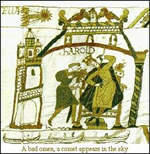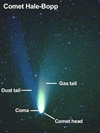 Comets are very different from asteroids and other space debris,
both in their composition and behaviour. They are mainly dirty ice blocks,
predominantly frozen water (H2O), with frozen carbon dioxide
(CO2), carbon monoxide (CO), and other ices, laced with rock
dust and a rich variety of organic compounds.
Comets are very different from asteroids and other space debris,
both in their composition and behaviour. They are mainly dirty ice blocks,
predominantly frozen water (H2O), with frozen carbon dioxide
(CO2), carbon monoxide (CO), and other ices, laced with rock
dust and a rich variety of organic compounds.
Typically, a comet is an irregularly shaped object with a nucleus a few kilometres across. Most comets spend their time at immense distances from the Sun, way outside the orbit of Pluto and about one-third of the way to the nearest star in a region called the Oort comet cloud, named after the Dutch astronomer Jan Oort. These comets have orbital periods of millions of years and their orbits can be inclined in any direction, that is, they can move around the Sun in any plane, not just the planetary plane.
We can only observe these visitors from the outer reaches of the Solar System when their highly elliptical orbits bring them close to the Sun on their perihelion passage, the part of their orbit nearest the Sun. Their presence in deep space is assumed from calculations of the orbits of comets as they approach the Sun in the inner Solar System.
Not all comets spend most of their life in the dark reaches of space in the Oort cloud. Halley’s Comet has a period of only 76 years and has a retrograde orbit around the Sun, that is, it goes backwards compared to the planets, or clockwise around the Sun. Halley’s Comet is an example of a short-period comet that has been captured by a close encounter with Jupiter, and thrown into a smaller orbit during its long journey from the Oort cloud towards the Sun. The next expected sitting of Halley’s comet will be in 2062.
Observing comets
 As a comet approaches the inner planets, its nucleus is warmed by the
Sun and it begins to release gases and dust that form the comet’s
coma and tail. These familiar characteristics only occur when the comet
is within the orbit of Jupiter, where the Sun's light is warm enough to
vaporise ice off the comet. Beyond Jupiter in cold space, the comet is
simply a lump of dirty frozen ice. Comets can form the most spectacular
astronomical shows with brilliant comas trailed by incredibly long tails,
and sometimes not only one tail!
As a comet approaches the inner planets, its nucleus is warmed by the
Sun and it begins to release gases and dust that form the comet’s
coma and tail. These familiar characteristics only occur when the comet
is within the orbit of Jupiter, where the Sun's light is warm enough to
vaporise ice off the comet. Beyond Jupiter in cold space, the comet is
simply a lump of dirty frozen ice. Comets can form the most spectacular
astronomical shows with brilliant comas trailed by incredibly long tails,
and sometimes not only one tail!
 |
Comet orbit |
 The
tale of two tails
The
tale of two tailsThe nucleus of the comet cannot be directly observed as it passes us in the inner Solar System, because the gases boiling off its surface form a bright ‘atmosphere’, or coma, of gas and dust which reflects light from the Sun, hiding the much smaller solid nucleus inside. These same gases and dust are then ‘blown’ away from the comet by the bombardment of ‘solar wind’ particles from the Sun to form a tail. This bright tail always points away from the Sun and changes direction as the comet passes by the Sun. A second, dimmer, tail can often be seen marking the orbit of the comet. This is created by dust, too big to be affected by the solar wind, coming off the comet nucleus and being left behind in a second trail marking the comet’s orbit.
| Copyright owned by the State of Victoria (Department of Education and Early Childhood Development). Used with Permission. |